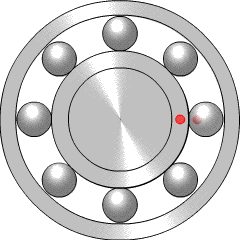A lubricant is a substance that helps to reduce friction between surfaces in mutual contact, which ultimately reduces the heat generated when the surfaces move. It may also have the function of transmitting forces, transporting foreign particles, or heating or cooling the surfaces. The property of reducing friction is known as lubricity.

A ball bearing is a type of rolling-element bearing that uses balls to maintain the separation between the bearing races.

Motor oil, engine oil, or engine lubricant is any one of various substances used for the lubrication of internal combustion engines. They typically consist of base oils enhanced with various additives, particularly antiwear additives, detergents, dispersants, and, for multi-grade oils, viscosity index improvers. The main function of motor oil is to reduce friction and wear on moving parts and to clean the engine from sludge and varnish (detergents). It also neutralizes acids that originate from fuel and from oxidation of the lubricant (detergents), improves the sealing of piston rings, and cools the engine by carrying heat away from moving parts.

A hydraulic fluid or hydraulic liquid is the medium by which power is transferred in hydraulic machinery. Common hydraulic fluids are based on mineral oil or water. Examples of equipment that might use hydraulic fluids are excavators and backhoes, hydraulic brakes, power steering systems, automatic transmissions, garbage trucks, aircraft flight control systems, lifts, and industrial machinery.
Tribology is the science and engineering of understanding friction, lubrication and wear phenomena for interacting surfaces in relative motion. It is highly interdisciplinary, drawing on many academic fields, including physics, chemistry, materials science, mathematics, biology and engineering. The fundamental objects of study in tribology are tribosystems, which are physical systems of contacting surfaces. Subfields of tribology include biotribology, nanotribology and space tribology. It is also related to other areas such as the coupling of corrosion and tribology in tribocorrosion and the contact mechanics of how surfaces in contact deform. Approximately 20% of the total energy expenditure of the world is due to the impact of friction and wear in the transportation, manufacturing, power generation, and residential sectors.

Synthetic oil is a lubricant consisting of chemical compounds that are artificially modified or synthesised. Synthetic lubricants can be manufactured using chemically modified petroleum components rather than whole crude oil, but can also be synthesized from other raw materials. The base material, however, is still overwhelmingly crude oil that is distilled and then modified physically and chemically. The actual synthesis process and composition of additives is generally a commercial trade secret and will vary among producers.
The NLGI consistency number expresses a measure of the relative hardness of a grease used for lubrication, as specified by the standard classification of lubricating grease established by the National Lubricating Grease Institute (NLGI). Reproduced in standards ASTM D4950(“standard classification and specification of automotive service greases”) and SAE J310(“automotive lubricating greases”), NLGI's classification is widely used. The NLGI consistency number is also a component of the code specified in standard ISO 6743-9“lubricants, industrial oils and related products — classification — part 9: family X (greases)”.

Gear oil is a lubricant made specifically for transmissions, transfer cases, and differentials in automobiles, trucks, and other machinery. It has high viscosity and usually contains organosulfur compounds. Some modern automatic transaxles do not use a heavy oil at all but lubricate with the lower viscosity hydraulic fluid, which is available at pressure within the automatic transmission. Gear oils account for about 20% of the lubricant market.
Grease is a solid or semisolid lubricant formed as a dispersion of thickening agents in a liquid lubricant. Grease generally consists of a soap emulsified with mineral or vegetable oil.
Oil analysis (OA) is the laboratory analysis of a lubricant's properties, suspended contaminants, and wear debris. OA is performed during routine predictive maintenance to provide meaningful and accurate information on lubricant and machine condition. By tracking oil analysis sample results over the life of a particular machine, trends can be established which can help eliminate costly repairs. The study of wear in machinery is called tribology. Tribologists often perform or interpret oil analysis data.
The Noack volatility test, named after Kurt Noack, determines the evaporation loss of lubricants in high-temperature service. This test is standardized as ASTM D5800.
Friction modifiers are added to lubricants in order to reduce friction and wear in machine components. They are particularly important in the boundary lubrication regime, where they can prevent solid surfaces from coming into direct contact, substantially reducing friction and wear.

Shell Rotella is a line of heavy-duty engine lubrication products produced by Shell plc. The line includes engine oils, gear oils and coolants. The oil carries both the American Petroleum Institute (API) diesel "C" rating as well as the API gasoline engine "S" rating. Ratings differ based on the oil. Rotella oils, like the T3 15W-40, meet both the API CJ-4 and SM specifications, and may be used in both gasoline and diesel engines. However, it is formulated specifically for vehicles without catalytic converters, containing phosphorus levels beyond the 600–800 ppm range. Therefore, Rotella is not recommended for gasoline vehicles with catalytic converters due to the higher risk of damaging these emission controls. Newer formulations of Rotella T6 however are API SM rated as safe for pre-2011 gasoline vehicles.
Oil additives are chemical compounds that improve the lubricant performance of base oil. The manufacturer of many oils can use the same base stock for each formulation and can choose different additives for each use. Additives comprise up to 5% by weight of some oils.
Crude oil is extracted from the bedrock before being processed in several stages, removing natural contaminants and undesirable hydrocarbons. This separation process produces mineral oil, which can in turn be denoted as paraffinic, naphthenic or aromatic. The differences between these different types of oils are not clear-cut, but mainly depend on the predominant hydrocarbon types in the oil. Paraffinic oil, for example, contains primarily higher alkanes, whereas naphthenic oils have a high share of cyclic alkanes in the mixture.

Automotive oil recycling involves the recycling of used oils and the creation of new products from the recycled oils, and includes the recycling of motor oil and hydraulic oil. Oil recycling also benefits the environment: increased opportunities for consumers to recycle oil lessens the likelihood of used oil being dumped on lands and in waterways. For example, one gallon of motor oil dumped into waterways has the potential to pollute one million gallons of water.
Base oils are used to manufacture products including lubricating greases, motor oil and metal processing fluids. Different products require different compositions and properties in the oil. One of the most important factors is the liquid’s viscosity at various temperatures. Whether or not a crude oil is suitable to be made into a base oil is determined by the concentration of base oil molecules as well as how easily these can be extracted.
Pour point depressants are used to allow the use of petroleum based mineral oils at lower temperatures. The lowest temperature at which a fuel or oil will pour is called a pour point. Wax crystals, which form at lower temperatures, may interfere with lubrication of mechanical equipment. High-quality pour point depressants can lower a pour point of an oil additive by as much as 40°C.
The mini-rotary viscometer is a device used to measure the pumpability of an engine oil at low temperatures. Engine oils must meet viscometric standards including those determined by the MRV in order to be classifiable within SAE J300 viscosity grades. The requirement was added after the winters of 1980-81 and 1981-82 caused major pumpability field problems in the US and Europe.

SAE J300 is a standard that defines the viscometric properties of mono- and multigrade engine oils, maintained by SAE International. Key parameters for engine oil viscometrics are the oil's kinematic viscosity, its high temperature-high shear viscosity measured by the tapered bearing simulator, and low temperature properties measured by the cold-cranking simulator and mini-rotary viscometer. This standard is commonly used throughout the world, and standards organizations that do so include API and ILSAC, and ACEA.








